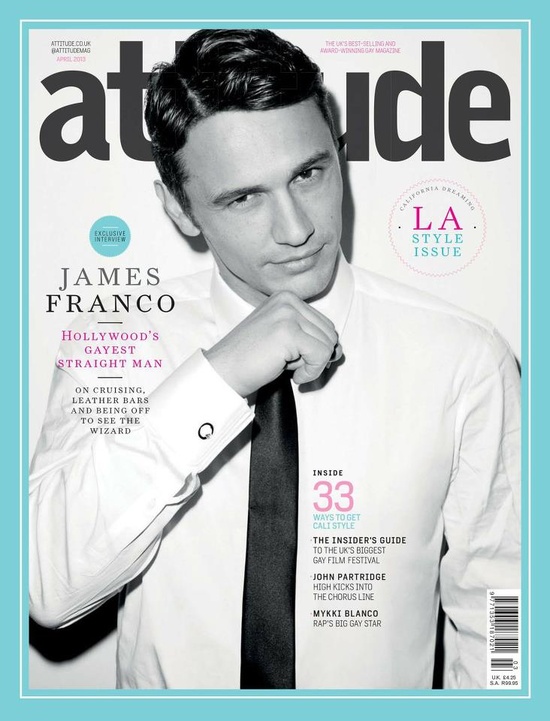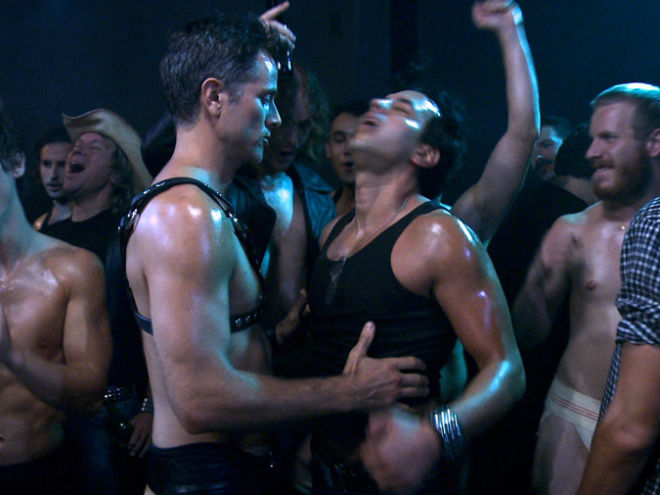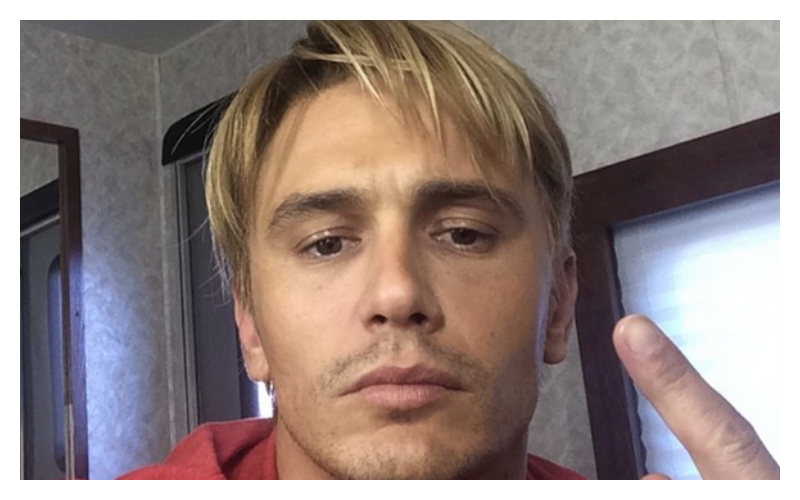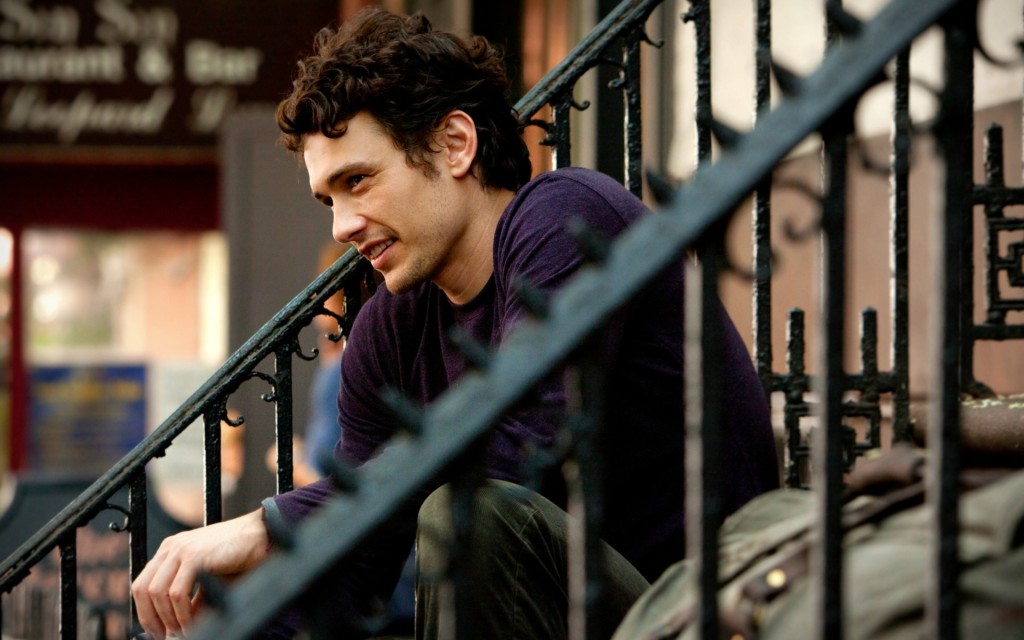Attitude archives: James Franco on his interest in queer culture
By Josh Haggis
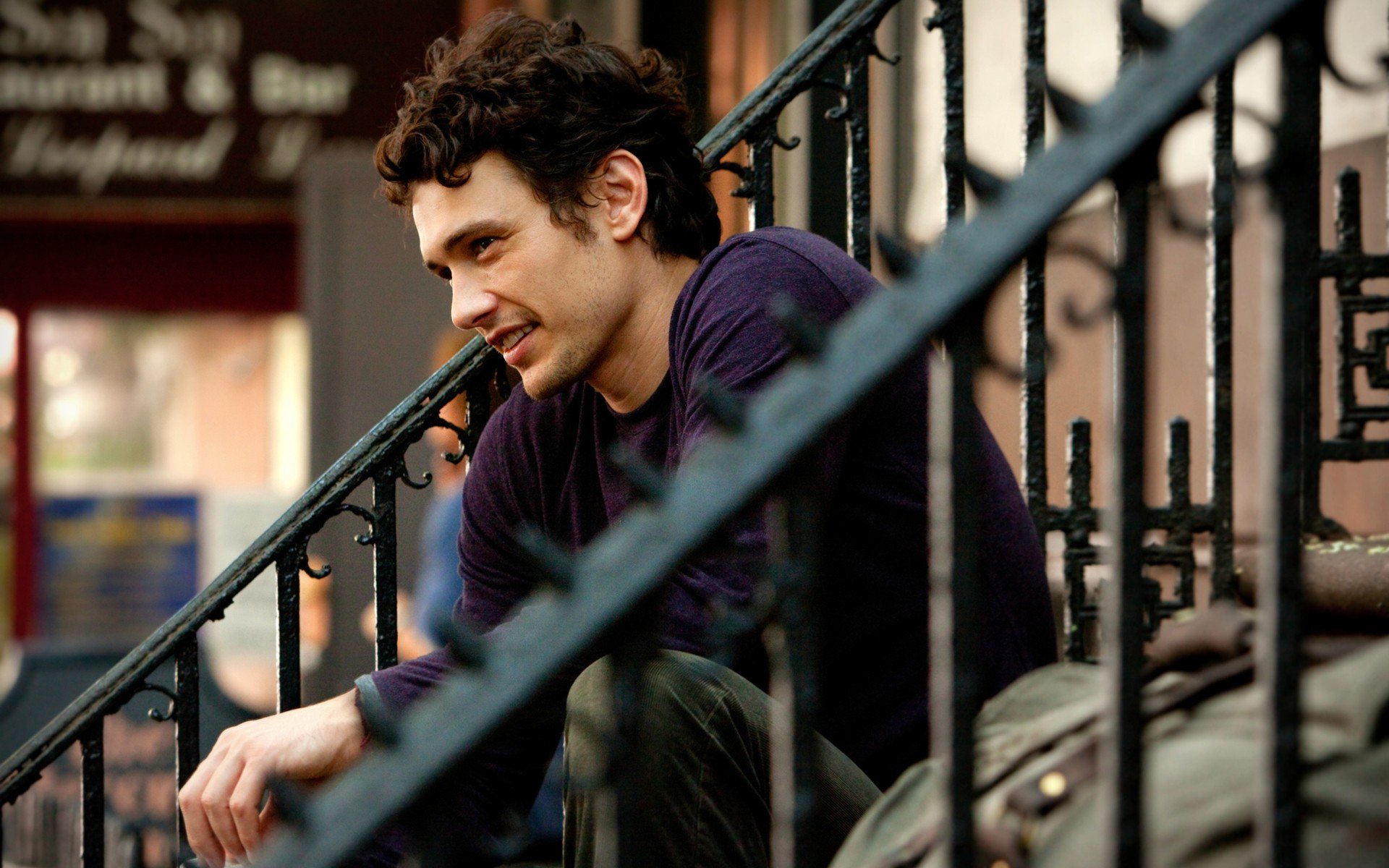
To celebrate I Am Michael’s forthcoming premiere at London’s BFI Flare LGBT film festival next month (March), we’ve decided to raid the Attitude Archives to take a look back at James Franco’s interview in our 2013 Style Issue.
James Franco is thinking. James Franco is always thinking. He may be lying on a hotel bed somewhere in L.A., done out in a black Gucci suit and looking movie-star gorgeous as he does the publicity rounds for his new film Oz the Great and Powerful, a rollicking, big-budget fantasy adventure that sets the scene for The Wizard Of Oz, the classic Judy Garland film that must surely be in the running for the title of the gayest film of all time.
‘It’s a great film with great people involved,’ says James, who plays a wizard much handsomer than the wizened old man he ends up in the 1939 film. ‘I’m a big Oz fan. I was a big fan when I was younger. I read all 14 of the Baum Oz books and loved the Judy Garland film, so I’ve been a fan for a long time.’
He may be the ‘go-to’ actor for huge, colourful, family-friendly movies such as Oz the Great and Powerful but that doesn’t mean he’s not a great thinker. And thinking can be a dangerous thing for a Hollywood movie star to do.
But then to call James Franco a Hollywood movie star is to undersell him dramatically. It’s like calling Leonardo Da Vinci the guy who came up with the idea for a funny sort of helicopter. It only tells a very small part of the story.
Apart from his prolific movie output – he stars in film films this year alone, not counting Oz the Great and Powerful – he is studying for his PhD at Yale, he is teaching at NYU and at USC, he has produced a documentary, he has written and co-directed a film, he had had a one-man show of his art called Gaytown in Berlin and Los Angeles, he has learned to fly a plane, he has written and published a book of short stories, he is the spokesperson for Gucci fragrances, he works for a charity that helps disabled children, he plays in a band called Daddy, he directed and narrated a dance theatre production called Collage, he’s made a short film about homophobic bullying, has directed REM video and he probably makes a very lovely apple crumble. Actually not probably. If he made an apple crumble it would be lovely, and no mistake. Probably with cinnamon in it.
In fact, it’s almost funny how much James Franco has on. Movie stars are notorious for telling hard-working people how busy they are, busy drinking tall mocha lattes, going to Pilates and topping up tans, no doubt. Not James Franco. He’s so busy it’s a wonder he has time to think. You can tell he’s thinking, by the way, because he leaves big gaps. So big you sometimes wonder if he’s still awake.
Another thing that sets James Franco apart from your run-of-the-mill movie star is that he positively embraces the whole gay thing – laps it up, he does, the more controversial the better – even though he’s not gay. Oh, there’s a lot of ‘Is he? Isn’t he?’ nonsense but he plainly isn’t. ‘One of the things that’s very much part of my public image is the question of my sexuality,’ he says nonchalantly. And despite early experiences of being bullied at school for seeming gay, he says ‘It’s not something that bothers me in the slightest. It hasn’t gone away and I get asked about it from all sides. It’s partly my doing and partly not my doing.’
Besides, he’s far too open about his interest in gay culture, gay sex even, to be a closet case. Most Hollywood movie stars of his stature would do anything to avoid any gay connection being made if they were gay. They will lie and date women, even marry them to avoid it. Stephen Fry’s Baftas opening shot about how he wasn’t the only actor in the room with a beard – a beard being slang for a woman brought along for the purposes of throwing off suspicions of homosexual leanings – was met with a shudder of ‘Please don’t pan the camera onto me’-ness. But James Franco embraces the gay world, and not only because he plays gay after gay after gay.
‘If I’m playing a gay character, sometimes the sexuality is secondary,’ he says, thinking as he speaks. ‘In the case of Allen Ginsberg [in Howl] and Hart Crane [in The Broken Tower, which he co-wrote and starred in], I was primarily interested in their artistic lives and their work. And their sexuality, because it played a part in their poems and their identities, became important for that reason. And because they were pushing boundaries of their own in their own time; in the 20s in the case of Hart Crane and in the 50s and 60s for Ginsberg.’ Pushing boundaries is a big part of James Franco’s raison d’être by the way. Watch out. It’ll come up again.
‘In the case of Milk,’ he says of the role Scott Smith, the boyfriend of gay activist Harvey Milk, as played by Sean Penn who won an Oscar for the role, ‘it’s a very important film for gay rights and gay culture, and just as a celebration of Harvey Milk as a person, but it’s also more universal. It’s about equal right for everyone.’
Aside from Oz the Great and Powerful, a full-scale Disney adventure where he stars with Mila Kunis, Rachel Weisz and Michelle Williams, James is promoting Interior. Leather Bar, a film that leaves the gayness of those previous projects way behind.
The film started out as an imagining of what bits of footage would have had to be left out of director William Friedkin’s notorious 1980 movie Cruising to get it past the censor. Cruising is notable not only because it was one of the first times the subject of homosexuality had been dealt with head-on in a Hollywood movie, but also because it came at a time when the gay movement was struggling to get respect.
To suggest that the whole of the gay experience was about going to dive bars to get pissed on and slapped – and maybe later murdered – didn’t really further the cause of gay people struggling to gain acceptance as regular human beings, and being pickets by activists outside cinemas, especially in America, ensued.
‘Cruising was controversial when it was made because, I think, juxtaposing a murder story with gay bars and gay lifestyles…’ (You can hear that he’s a scholar, can’t you, with his ‘juxtaposings’?) ‘…had an unfortunate resonance,’ he explains. ‘Even though I don’t think Friedkin had any intention of depicting gay culture in a bad way.’
The reason we’re talking about Milk and Interior. Leather Bar in the same sentence is that they are set broadly in the same era, and I’ve mentioned that, as important a figure as Harvey Milk was in moving gay politics on, things don’t really seem to have changed that much in 30 or more years, especially in the US, where Jodie Foster can only almost come out and the President even mentioning the word ‘gay’ in his inaugural address can cause nationwide hyperventilation. The black civil rights movement didn’t take this long.
‘In some way there’s been progress,’ says James after a lengthy thinking pause. ‘And in some ways there hasn’t. It was one of the things I wanted to explore when we made Interior. Leather Bar. I wanted to somehow explore similar subject matter to Cruising to see how things had changed in 30 years. Or hadn’t changed. To see how things are represented in the film, what can we show, what is accepted, how do people accept things now… That was the initial idea and it developed from there.’
What we see on screen in Interior. Leather Bar is James watching as real live gay men have real live gay sex, some of it is pretty hardcore, right there in front of him, within sniffing distance – so close you could touch it. James, at one stage, actually winces as some guy’s arse get’s a sound beating:
‘One of the reasons that I initially met with Travis Matthews [his co-director on the film] was that I had never directed scenes with actual sex and I wanted someone who had more experience,’ he explains, through his film The Feast of Stephen, a four-minute art movie that you can find online, does feature scarily young lads, naked and molesting each other quite violently.
‘I thought I was going to get a regular pornography director and then I met Travis,’ James adds, ‘He was using real sex in his films in a very interesting way. Not for titillation but to tell the story: the sex was a depiction of behaviour between the characters so it revealed character and story rather than being there for titillation. That’s why I asked him to be a full collaborator.’
James explains that he had done a class in The Human Body in Film as part of his studies and watched movies such as the genius Shortbus as examples of how explicit sex scenes could be used not just to turn the audience on but to tell the tale.
In fact, his interest in gay culture comes largely from his studies. ‘I took Queer Culture at NYU,’ he says, ‘and at Yale I took a few classes on Queer Cinema. At Yale I worked with Michael Warner, who’s a big queer theorist whose ideas have influenced me.’ He hopes that Interior. Leather Bar will be accepted as part of the queer cinema canon, shown in courses like the ones he took. “The final project is a queer piece of art in itself,” he says.
So how does he rate the experience of watching guys have full-on sex right there in front of him? He thinks. ‘Yeah, it was fine. It was, er… Travis really took the lead in directing those scenes. I’ve done films with artists before when the material goes beyond what I used to be in mainstream films and it felt like that. It was in line with some other artistic project I’d been doing.’
As part of his research for Sonny back in 2002, he apparently befriended a male prostitute who let him watch while he had sex with a client, just to get a feel for what it’s like to work in the sex industry. He’s also done work with fine artist Paul McCarthy, who uses porn performers. He collaborated with McCarthy on a film called Rebel, wherein James had the name of actor Brad Renfro tattooed on his arm in real time. Another collaborator on that project was Harmony Korine, the man behind another of James’s 2013 movies, the simply brilliant Spring Breakers, where he plays an unrecognisable gang-banger complete with silver teeth, corn-rows and as many guns as tattoos. Like we said, busy lad.
So, on one hand you have highly enjoyable, highly mainstream movies such as the new Oz the Great and Powerful, the sort of film that will be shown at Christmas for years to come, and of course, the Spider-Man movies, and on the other you have art films about gay sex and sexual molestation and self harm. Oh, and he’s produced a documentary called Kink about a porn studio that specialises in hard-core S&M. But how does a full-scale A-list Hollywood actor in an era where an interest in matters sexual is unwelcome to say the least keep those two opposing plates spinning?
‘I guess I have a variety of interests,’ he says. ‘Like I say, I’ve been a fan of the Oz books since I was a kid and it was a chance to work with my old friend Sam Raimi [the director of the Spider-Man movies]. But it’s a Disney film and my job is to bring the role to life, not to bring controversy. But if I do a film that’s going to be released at Sundance [the famous indie film festival where Kink and Interior. Leather Bar were premiered] that’s a chance to make a film that’s going to push boundaries. They’re just different areas, I guess.’
But with Disney films on the one hand and films featuring real, non-simulated gay sex on the other, how on Earth does he manage to have his cake and eat it? How does he sustain a family-friendly career with all this cutting-edge stuff going on, when most Hollywood movie stars would run a mile from controversial material?
‘It is a risk,’ he concedes. ‘The films I have in Sundance this year did get a lot of praise, but I did get some pressure – not from Disney at all – but I did get pressure from other areas. I was supposed to do a commercial with this company and they pulled out because they weren’t happy, they didn’t like the subject matter of the films at Sundance.’
What company? Name and shame, name and shame, name and shame. James Franco laughs. And thinks.
‘It was a champagne company. You’d think they’d be grown up enough but I’ve had it happen with this company, and a car company as well.’
It takes quite some Hollywood movie star to turn down cold hard cash for the sake of his art but it seems that is what James Franco is all about. ‘If I’m at the threshold of doing a project,’ he explains, ‘and the question comes up, “Will this be harmful to your career?”, I never want that to be the deciding factor.’
Thank God for James Franco. Big old handsome old hard-thinking, pro-gay James Franco, bringing some sanity, some intelligence and some hard-core man-on-man action to a cinema screen near you, even if it is a screen that does carrot cake in the foyer. But what about an upfront, glad-to-be-gay A-list Hollywood actor star? How long are we going to wait for one of those to come along?
‘I think that the people I have known who are performers who haven’t publicly come out didn’t because they’re afraid it’ll hurt their careers,’ he says. ‘And they’re afraid they won’t be able to play straight roles any more.’
But in a set-up where a straight actor like Sean Penn can get an Oscar for playing a gay man, is it really true that a gay actor would never be able to play a straight role again if he came out?
‘I think you’re right,’ says James. ‘Now that you’ve said that, I think I could see a really big name coming out and doing that. I think the time is about right. I’m not an authority on this but if I think about it for a second…’ There he goes, thinking again. ‘If there is somebody that was well respected and very secure with their career. I could see it happening in a very positive way.’
It’s going to be a very tricky one, especially as the well-respected Hollywood movie stars who are secure with their careers tend to have had a string of publicist-approved ‘girlfriends’, all of whom would be exposed as collaborators if the lying were to come to an end. How would all those ex-wives and ex-girlfriends explain their complicity in the career-propping lies that they’d been implicated in if a major movie star were to come out?
Until the first coming out of a major Hollywood star of this generation happens, it looks like we’re going to have to depend on James Franco to be our representative. And let’s face it, we could do a lot worse. Not only is he a top-rate actor, a scholar, an artist and – yes! – a thinker, he’s a risk-taker, and heaven knows there are not many of those knocking around modern-day Hollywood.

